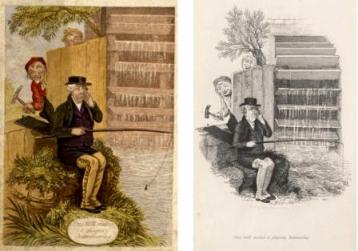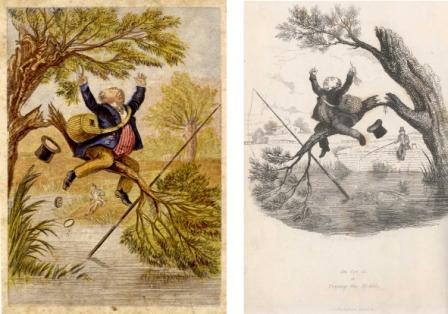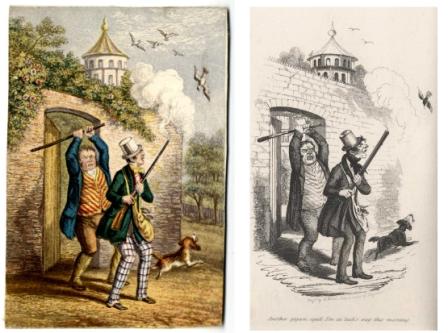Print of the Month - June 2020
 |
| An elderly sportsman is angling in the eddy of a mill stream, whilst his coat tails are being nailed fast by the Miller's men. |
| Left - Kronheim’s 'The Noisy Mill' (BT 500) <> Right - Seymour’s Sketches - 'This mill makes a plaguey hammering' |
Kronheim & Co produced a number of sheets of humorous sporting scenes based on “Seymour’s Humorous Sketches”.
These caricature sketches, originally produced between 1834 and 1836, were hugely popular and continued to be so during the time that Kronheim was printing in colour using the Baxter process.
Robert Seymour, apprenticed as a pattern-drawer, was an artist who exhibited at the Royal Academy in 1822 at the age of 24, but he turned to book illustration after his second submission was rejected by the Academy.
 |
| Left - Kronheim’s 'I’ll step back' (BT 413) <> Right - Seymour’s Sketches 'I’ll creep back a step or two' |
 |
| Left - Kronheim’s 'Unseated' (BT 499) <> Right - Seymour’s Sketches 'In for it, or Trying the Middle' |
 |
| Left - Kronheim’s 'Shot and recoil' (BT 465) <> Right - Seymour’s Sketches - 'Another pigeon!', also known as 'The Farmer's whack' |
He made a comfortable living creating illustrations for a wide range of subjects including poetry, novels, children’s stories, as well as topographical and scientific works, but in 1827 he suffered a blow when his publishers went bankrupt owing him a large amount of money.
He then learnt how to etch on the newly fashionable steel plates and began to specialise in caricatures and other humorous subjects.
This proved very successful.
He produced work for the caricature magazines “The Looking Glass” and “Figaro in London” (pre “Punch”) and was so prolific that it’s been estimated that he produced a third of all of the British political cartoons of this era.
He was soon considered to be a great illustrator and was dubbed "The Shakespeare of caricature"
In 1834, at the height of his popularity, Seymour launched a series called “Sketches by Seymour”, originally comprising 197 images of farcical sporting adventures and urban incidents.
Then in the autumn of 1835 Seymour was brought together with Charles Dickens by the publishing firm Chapman and Hall to link the sporting illustrations with some anecdotal text.
At this stage Dickens was a “hack” writer of only 24 and Seymour was his superior by 12 years and a well-established and very popular illustrator.
However Dickens was a forceful personality, whilst Seymour was highly strung, extremely sensitive about his status as an artist and had suffered a nervous breakdown in 1830.
It appears that the relationship between Dickens and Seymour has not a happy one.
Their work became “The Pickwick Papers”, issued monthly, with more of a focus on adventures in coffee houses and inns than sporting escapades, and with a greater focus on the text by Dickens and far less emphasis on the illustrations by Seymour.
Dickens very much became the driving force, with strong views about the illustrations.
In April 1936 Seymour went to Dickens' home to discuss the drawings.
Dickens was said to be very critical of Seymour’s work and there was apparently a great argument.
Whatever happened at the meeting, the final outcome was that two days later Seymour committed suicide, shooting himself with his hunting rifle in the summerhouse of his Islington garden.
Seymour’s very dramatic death at the height of his career did much to perpetuate the popularity of his sketches which were reissued on numerous occasions between 1841 and 1888.
Seymour’s early death not only allowed his images to be more widely used, but was used as a marketing tool by some - it was even said that Henry Wallis, who bought the lithographic stones and copyright, could barely contain his excitement at the commercial opportunity given him by Seymour’s widely reported sudden death.
It is not known when Kronheim printed his version of Seymour’s sketches, although it is likely that is was between 1850 and 1870.
The addition of colour using Baxter’s patented colour process would have made the already popular sketches even more popular.
Kronheim used images from Seymour’s Sketches on at least three sheets of prints.
Each of these sheets had 8 images, each measuring about 8 cm x 5.5 cm.
These humorous sporting prints by Kronheim can be found as individual prints, used on textile labels, and as trade cards with text printed on the back.
We have never seen them in a book, but would be very interested to hear from anyone who has any further information.